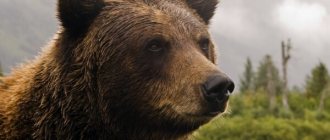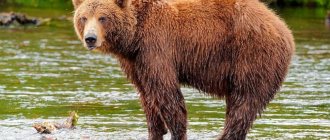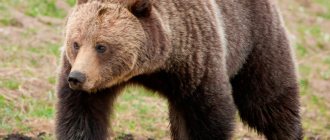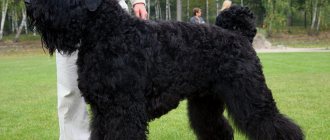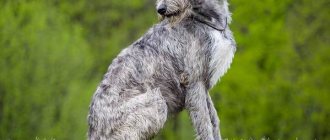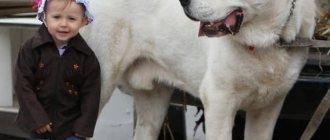- Wild animals
- >>
- Mammals
The giant panda is a unique animal, also called the bamboo bear.
Today there is a possibility of complete extinction of this species of animals from the face of the earth, and therefore they are listed in the International Red Book. Bamboo bears are a symbol and national treasure of the People's Republic of China. They are awarded the honorary title of the cutest animal on our planet. Bears are one of the most interesting, oldest and rarest representatives of the animal world on earth.
Panda habitat - in which country do they live?
Panda habitat
Pandas are distributed primarily in Asia, east of the Himalayan mountains. At the same time, small pandas are much more common than big pandas. The animals are extremely rare; the population of giant pandas is limited to the provinces of China: Gansu, Sichuan and Shanxi, which are located in the center of the country. The habitat covers about 29.5 thousand km2, but only a small part can be considered the habitat of pandas.
Interesting fact: Panda is translated from Chinese as bear-cat.
Getting to know Europe
The world first learned about these cute animals in 1869. David Armand, a French missionary who traveled to Mongolia, Tibet and China and collected rich zoological collections on his travels, returned to his homeland and demonstrated in Paris the skin of an unprecedented black and white bear, which was placed in the Natural History Museum. However, bringing the skin of an unknown animal to the West is one thing, but proving that it actually exists is a completely different matter. Many European scientists were convinced that such a large animal simply could not exist in nature. The unusual color of the unknown animal also raised great doubts. Many were convinced that the skin shown by Armand was the result of the work of skilled craftsmen who sewed several skins together and thus obtained this result.
But David Armand did not give up. He proved to the world that the skin he brought belonged to a real animal. He took another trip to the east and presented the skeleton of a panda to the Western world, accompanied by the story of the hunter who caught the panda.
Panda Habitat
Panda Habitat
Pandas live in deciduous forests and mountainous areas. They feed mainly on bamboo, which is why they choose habitats where it grows. A lot of bamboo grows in the territories of Tibet and Sichuan province, so most of the animals live there. Mountain forests are simply filled with bamboo thickets. Pandas mostly live solitary lives, moving only to obtain food, systematically chewing leaves and stems of bamboo.
Description
Panda appearance
Panda appearance
Panda appearance
Panda appearance
Panda appearance
Giant pandas have a round head, a plump and stocky body, and a very short tail. They reach 70 cm at the shoulders. The animals have become popular because of their cute faces and black markings around the eyes and along the body. Pandas' limbs, ears, and areas around the eyes are black, while the rest of the body is predominantly white. Sometimes pandas may not have black spots, but dark red ones. Dark spots give pandas a somewhat naive, trusting appearance.
Interesting fact : It has long been believed that bamboo bears are related to raccoons.
The shoulders and neck are very wide, but the hind limbs are reduced, so the animals walk with a kind of amble. Pandas have a reproductive bone, the baculum, present in some mammals, but it is S-shaped, pointing backwards. In giant pandas, the cranial bones are connected several times; there is a large sagittal crest, widened and deepened due to the powerful wide jaws.
Interesting fact : the giant panda is considered a bear, but the red panda is considered a raccoon.
Red panda
The molars and small molars are somewhat wider and flatter than those of other bears, which is why pandas can chew hard bamboo stems. The main notable feature of the body structure is the opposed protrusion on the bunch, similar to a thumb. Scientists previously assumed that this skin protrusion was a real finger, causing confusion in the classification of animals.
Interesting fact : for a long time it was believed that pandas have six fingers, not five. This was due to a small skin growth used to break the bamboo stems.
Appearance
In appearance, the black and white panda resembles a bear. The coloring of these animals is very specific - the white color of the fur is diluted with black on the ears, legs and shoulders, and also around the eyes creating the effect of “black glasses”. Scientists believe that this unique color is explained by the natural habitat, in which such “camouflage” provided camouflage and protection in rocks covered with patches of snow. Thick wool perfectly warms animals in the cool forests of their habitat. Pandas' jaws have strong muscles and are equipped with molars.
Pandas have short and thick hind legs. There are smooth pads on the soles, as well as at the base of the toes, that comfortably hold the bamboo stems. Usually the animal breaks off young bamboo shoots with its front paws and methodically eats its favorite delicacy: leaves, shoots and stems. A special feature of the structure of pandas' paws is the sixth toe, which acts as a thumb, as well as the presence of a rather long tail for bears, which can grow up to 12 cm. Chinese scientists have established that in ancient times pandas were not such large animals. The discovery of an ancient panda skull, which they discovered in southern China, proved that previously pandas were one and a half times smaller.
Reproduction
Panda cubs
Female giant pandas become much calmer during the mating season and attract males with a special smell. Several males may compete for a female. Mating games take place throughout the spring. During the most important days of mating games, all the female’s activity ceases, they begin to get nervous and stop eating.
Interesting: Is a panda a bear? Description, photo and video
Most panda offspring appear in August-September; pregnant females carry their offspring for about 6 weeks. Newly born cubs are blind, helpless, and their entire body is covered with a thin layer of fur. Newborn cubs weigh up to 140 grams. When the baby is born, the mother takes full care of it and moves it to a position that is comfortable for sucking milk.
Newborn panda bears
Interesting fact : for some time after birth, pandas are only white.
Feeding a baby takes up to half an hour, and a bear cub can want to eat up to 14 times a day. The eyes open three weeks after birth, animals can move independently only after 3-4 months, and are completely weaned from milk at the age of 46 weeks. The cubs stay with their mother for up to one and a half years.
Development of panda cubs
Reproduction in captivity is very poor. Studying the behavioral characteristics of animals in captivity, scientists noticed that mostly twins are born. At the same time, the mother does not raise both cubs, giving preference to only one. With a high probability, the second cub dies from hunger.
Why does panda breed poorly in captivity?
Now pandas are considered one of the most popular animals; they can be called the stars of the animal world. The sad news is that there are practically no pandas left on the planet. This also happens because animals do not reproduce well in captivity.
Zoologists help pandas
Zoologists around the world are trying to solve the problem of panda reproduction. Scientists understand that this task is not an easy one; they are constantly studying the mating games of bears. We can say that at the moment the mating games of pandas in captivity have been studied thoroughly. Females can conceive only within a few days each year - in March, and males are ready to reproduce as early as January: their hormonal levels change, males constantly mark their territory, etc.
Males arrange battles for the female’s attention; the winner ultimately takes care of his female, waiting for her to be ready. The most persistent males bother the females - they have to flee from them. Females distinguish dominant males by their voice.
Summer is approaching, mating games gradually cease, males can no longer engage in mating games until next spring. At the same time, in the wild, animals continue to reproduce, but in captivity they become modest and may not even show any activity during mating games.
Scientists explain this laziness by the fact that in captivity the male does not always understand whether the female is ready to reproduce. This happens because the animals’ enclosures are different, there is not so much communication for the male to understand the female’s readiness to conceive. In captivity, it is necessary to create special conditions, arrange dates for the animals, during which the females can signal to the males that they are ready.
It is still difficult to establish the exact reason for the weak activity of animals in captivity. The demographic situation of bears is very complex, so scientists are constantly trying to find out the reasons and correct the situation.
Features of character and lifestyle
Photo: Animal big panda
Pandas are naturally endowed with the ability to climb trees deftly and very quickly. Despite this, they prefer to be on the ground most of the time. They are excellent swimmers. Animals are distinguished by great caution and secrecy. They try their best to hide from people. In this regard, people knew nothing about them for a very long time. Observing animals living in captivity, people noted very dignified, majestic behavior. Bamboo bears behave like real representatives of noble blood.
Interesting fact: Royalty is conveyed by special manners of behavior, especially the poses that pandas are able to take. During periods of rest, they often sit as if occupying a place of honor on a throne. They rest their backs against a tree or other support; they can place their upper limbs on a hill and cross their lower limbs.
There is no clear pattern of animal activity depending on the time of day. They can be active at any time of the day. Bamboo bears spend up to 10-12 hours a day searching for and eating food. With the onset of cold weather and lower ambient temperatures, people may sleep more than usual. However, this is not at all like bear hibernation.
Animals prefer to lead a solitary lifestyle. It is unusual for them to exist in a group setting. Each animal has its own territory, which it actively protects. Females are especially ardent defenders. Animals also do not create long and strong pairs.
Despite the fact that pandas are considered silent and secretive animals, they tend to communicate with each other through sounds. Babies who call their mother make sounds similar to whimpering or crying. When pandas greet their relatives, they make something similar to the bleating of sheep. The anger and indignation of bamboo bears is expressed by a roar. If the animal does not make any sounds, but at the same time shows a bared teeth, it is better to keep your distance, as the panda is angry and furious. In general, the animals are very friendly and not at all aggressive.
Life expectancy of a panda in the wild and in zoos
Panda at the zoo
Giant pandas are omnivorous mammals that look like ordinary bears. Animals can live in the wild for up to 15 years, sometimes they can live to a respectable age.
In captivity, pandas can live much longer - from 25 to 35 years. The longevity of pandas in zoos can be explained by the following reasons:
- constant careful care and supervision of bears, access to food is provided at all times, the diet is balanced, animals receive a lot of vitamins and nutrients from fruits;
- complete control over animal reproduction. This happens because pandas are listed in the Red Book. Animal multiplication is very important;
- constant care and vaccination of animals against various diseases, solving health problems by highly qualified veterinarians.
Interesting: Chameleon
